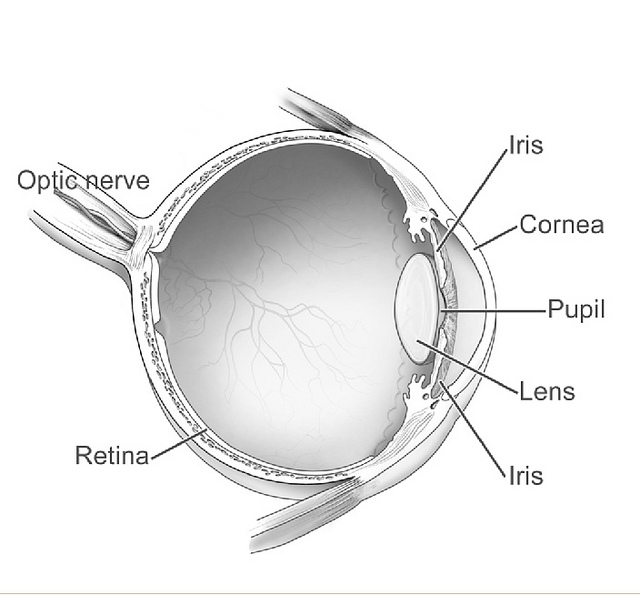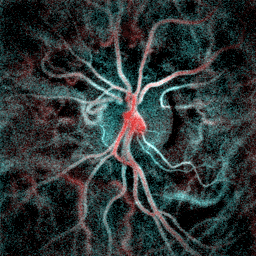|
Neovascularization
Neovascularization is the natural formation of new blood vessels ('' neo-'' + ''vascular'' + '' -ization''), usually in the form of functional microvascular networks, capable of perfusion by red blood cells, that form to serve as collateral circulation in response to local poor perfusion or ischemia. Growth factors that inhibit neovascularization include those that affect endothelial cell division and differentiation. These growth factors often act in a paracrine or autocrine fashion; they include fibroblast growth factor, placental growth factor, insulin-like growth factor, hepatocyte growth factor, and platelet-derived endothelial growth factor. There are three different pathways that comprise neovascularization:(1) vasculogenesis,(2) angiogenesis, and (3) arteriogenesis. Three pathways of neovascularization Vasculogenesis Vasculogenesis is the de novo formation of blood vessels. This primarily occurs in the developing embryo with the development of the first primitive vascula ... [...More Info...] [...Related Items...] OR: [Wikipedia] [Google] [Baidu] |
Corneal Neovascularization
Corneal neovascularization (CNV) is the in-growth of new blood vessels from the pericorneal plexus into avascular corneal tissue as a result of oxygen deprivation. Maintaining avascularity of the corneal stroma is an important aspect of corneal pathophysiology as it is required for corneal transparency and optimal vision. A decrease in corneal transparency causes visual acuity deterioration. Corneal tissue is avascular in nature and the presence of vascularization, which can be deep or superficial, is always pathologically related. Corneal neovascularization is a sight-threatening condition that can be caused by inflammation related to infection, chemical injury, autoimmune conditions, immune hypersensitivity, post-corneal transplantation, and traumatic conditions among other ocular pathologies. Common causes of CNV within the cornea include trachoma, corneal ulcers, phylctenular keratoconjunctivitisrosacea keratitis interstitial keratitissclerosing keratitis chemical burns, a ... [...More Info...] [...Related Items...] OR: [Wikipedia] [Google] [Baidu] |
Rubeosis Iridis
Rubeosis iridis is a medical condition of the iris of the eye in which new abnormal blood vessels (formed by neovascularization) are found on the surface of the iris. Causes This condition is often associated with diabetes in advanced proliferative diabetic retinopathy. Other conditions causing rubeosis iridis include central retinal vein occlusion, ocular ischemic syndrome, and chronic retinal detachment. Pathophysiology It is usually associated with disease processes in the retina, which involve the retina becoming starved of oxygen (ischaemic). The ischemic retina releases a variety of factors, the most important of which is vascular endothelial growth factor (VEGF). These factors stimulate the formation of new blood vessels ( angiogenesis). These new vessels do not have the same characteristics as the blood vessels originally formed in the eye. In addition, new blood vessels can form in areas that do not have them. Specifically, new blood vessels can be observed on the ... [...More Info...] [...Related Items...] OR: [Wikipedia] [Google] [Baidu] |
Choroidal Neovascularization
Choroidal neovascularization (CNV) is the creation of new blood vessels in the choroid layer of the eye. Choroidal neovascularization is a common cause of neovascular degenerative maculopathy (i.e. 'wet' macular degeneration) commonly exacerbated by extreme myopia, malignant myopic degeneration, or age-related developments. Causes CNV can occur rapidly in individuals with defects in Bruch's membrane, the innermost layer of the choroid. It is also associated with excessive amounts of vascular endothelial growth factor (VEGF). As well as in wet macular degeneration, CNV can also occur frequently with the rare genetic disease pseudoxanthoma elasticum and rarely with the more common optic disc drusen. CNV has also been associated with extreme myopia or malignant myopic degeneration, where in choroidal neovascularization occurs primarily in the presence of cracks within the retinal (specifically) macular tissue known as lacquer cracks. Symptoms CNV can create a sudden deterioration ... [...More Info...] [...Related Items...] OR: [Wikipedia] [Google] [Baidu] |
Angiogenesis
Angiogenesis is the physiological process through which new blood vessels form from pre-existing vessels, formed in the earlier stage of vasculogenesis. Angiogenesis continues the growth of the vasculature by processes of sprouting and splitting. Vasculogenesis is the embryonic formation of endothelial cells from mesoderm cell precursors, and from neovascularization, although discussions are not always precise (especially in older texts). The first vessels in the developing embryo form through vasculogenesis, after which angiogenesis is responsible for most, if not all, blood vessel growth during development and in disease. Angiogenesis is a normal and vital process in growth and development, as well as in wound healing and in the formation of granulation tissue. However, it is also a fundamental step in the transition of tumors from a benign state to a malignant one, leading to the use of angiogenesis inhibitors in the treatment of cancer. The essential role of angi ... [...More Info...] [...Related Items...] OR: [Wikipedia] [Google] [Baidu] |
Vascular Endothelial Growth Factor
Vascular endothelial growth factor (VEGF, ), originally known as vascular permeability factor (VPF), is a signal protein produced by many cells that stimulates the formation of blood vessels. To be specific, VEGF is a sub-family of growth factors, the platelet-derived growth factor family of cystine-knot growth factors. They are important signaling proteins involved in both vasculogenesis (the '' de novo'' formation of the embryonic circulatory system) and angiogenesis (the growth of blood vessels from pre-existing vasculature). It is part of the system that restores the oxygen supply to tissues when blood circulation is inadequate such as in hypoxic conditions. Serum concentration of VEGF is high in bronchial asthma and diabetes mellitus. VEGF's normal function is to create new blood vessels during embryonic development, new blood vessels after injury, muscle following exercise, and new vessels (collateral circulation) to bypass blocked vessels. It can contribute to disease. S ... [...More Info...] [...Related Items...] OR: [Wikipedia] [Google] [Baidu] |
Collateral Circulation
Collateral circulation is the alternate circulation around a blocked artery or vein via another path, such as nearby minor vessels. It may occur via preexisting vascular redundancy (analogous to engineered redundancy), as in the circle of Willis in the brain, or it may occur via new branches formed between adjacent blood vessels ( neovascularization), as in the eye after a retinal embolism or in the brain when moyamoya occurs. Its formation may be provoked by pathological conditions such as high vascular resistance or ischaemia. An example of the usefulness of collateral circulation is a systemic thromboembolism in cats. This is when a thrombotic embolus lodges above the external iliac artery (common iliac artery), blocking the external and internal iliac arteries and effectively shutting off all blood supply to the hind leg. Even though the main vessels to the leg are blocked, enough blood can get to the tissues in the leg via the collateral circulation to keep them aliv ... [...More Info...] [...Related Items...] OR: [Wikipedia] [Google] [Baidu] |
Bruch's Membrane
Bruch's membrane is the innermost layer of the choroid of the eye. It is also called the ''vitreous lamina'' or ''Membrane vitriae'', because of its glassy microscopic appearance. It is 2–4 μm thick. Layers Bruch's membrane consists of five layers (from inside to outside): #the basement membrane of the retinal pigment epithelium #the inner collagenous zone #a central band of elastic fibers #the outer collagenous zone #the basement membrane of the choriocapillaris The retinal pigment epithelium transports metabolic waste from the photoreceptors across Bruch's membrane to the choroid. Embryology Bruch's membrane is present by midterm in fetal development as an elastic sheet. Pathology Bruch's membrane thickens with age, slowing the transport of metabolites. This may lead to the formation of drusen in age-related macular degeneration. There is also a buildup of deposits (Basal Linear Deposits or BLinD and Basal Lamellar Deposits BLamD) on and within the membrane, primarily c ... [...More Info...] [...Related Items...] OR: [Wikipedia] [Google] [Baidu] |
Placental Growth Factor
Placental growth factor (PlGF) is a protein that in humans is encoded by the ''PGF'' gene. Placental growth factor (PGF) is a member of the VEGF (vascular endothelial growth factor) sub-family - a key molecule in angiogenesis and vasculogenesis, in particular during embryogenesis. The main source of PGF during pregnancy is the placental trophoblast. PGF is also expressed in many other tissues, including the villous trophoblast. The placental growth factor (PGF) gene is a protein-coding gene and a member of the vascular endothelial growth factor (VEGF) family. The PGF gene is expressed only in human umbilical vein endothelial cells (HUVE) and the placenta. PGF is ultimately associated with angiogenesis. Specifically, PGF plays a role in trophoblast growth and differentiation. Trophoblast cells, specifically extravillous trophoblast cells, are responsible for invading the uterine wall and the maternal spiral arteries. The extravillous trophoblast cells produce a blood vessel ... [...More Info...] [...Related Items...] OR: [Wikipedia] [Google] [Baidu] |
Inosculation
Inosculation is a natural phenomenon in which trunks, branches or roots of two trees grow together in a manner biologically similar to the artificial process of grafting. The term is derived from the Latin roots ''in'' + '' ōsculārī'', "to kiss into/inward/against" or etymologically and more illustratively "to make a small mouth inward/into/against"; trees having undergone the process are referred to in forestry as gemels, from the Latin word meaning "a pair". It is most common for branches of two trees of the same species to grow together, though inosculation may be noted across related species. The branches first grow separately in proximity to each other until they touch. At this point, the bark on the touching surfaces is gradually abraded away as the trees move in the wind. Once the cambium of two trees touches, they sometimes self-graft and grow together as they expand in diameter. Inosculation customarily results when tree limbs are braided or pleached. The term ''i ... [...More Info...] [...Related Items...] OR: [Wikipedia] [Google] [Baidu] |
Revascularization
In medical and surgical therapy, revascularization is the restoration of perfusion to a body part or organ that has had ischemia. It is typically accomplished by surgical means. Vascular bypass and angioplasty are the two primary means of revascularization. The term derives from the prefix re-, in this case meaning "restoration" and vasculature, which refers to the circulatory structures of an organ. It is often combined with "urgent" to form urgent vascularization. Revascularization involves a thorough analysis and diagnosis and treatment of the existing diseased vasculature of the affected organ, and can be aided by the use of different imaging modalities such as magnetic resonance imaging, PET scan, CT scan, and X-ray fluoroscopy. Applications For coronary artery disease (ischemic heart disease), coronary artery bypass surgery and percutaneous coronary intervention (coronary balloon angioplasty) are the two primary means of revascularization. When those cannot b ... [...More Info...] [...Related Items...] OR: [Wikipedia] [Google] [Baidu] |
Aqueous Humour
The aqueous humour is a transparent water-like fluid similar to plasma, but containing low protein concentrations. It is secreted from the ciliary body, a structure supporting the lens of the eyeball. It fills both the anterior and the posterior chambers of the eye, and is not to be confused with the vitreous humour, which is located in the space between the lens and the retina, also known as the posterior cavity or vitreous chamber. Blood cannot normally enter the eyeball. Structure Composition * Amino acids: transported by ciliary muscles *98% water * Electrolytes ( pH = 7.4 -one source gives 7.1) **Sodium = 142.09 **Potassium = 2.2 - 4.0 **Calcium = 1.8 **Magnesium = 1.1 **Chloride = 131.6 **HCO3- = 20.15 **Phosphate = 0.62 ** Osm = 304 *Ascorbic acid *Glutathione * Immunoglobulins Function *Maintains the intraocular pressure and inflates the globe of the eye. It is this hydrostatic pressure that keeps the eyeball in a roughly spherical shape and keeps the walls of the eye ... [...More Info...] [...Related Items...] OR: [Wikipedia] [Google] [Baidu] |




